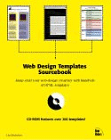Collection of 300 Basic HTML Templates
Not a great investment for sophisticated web developers, adequate for newbies, useful information, potential source of ideas, fundamental reminders.
ORIGINAL DRAFT
There are numerous ways to get a web site up and running quickly. You can use one of the many WYSIWYG programs available and pull from their template collections, or look around the web for examples. Another approach is to pick up a book that provides examples you can follow. When the book comes with a CD, organized for adaptation, as is the Web Design Templates Sourcebook, you have yet another resources at your disposal. Depending on your web development budget, you may find this book a good investment.
The book is divided into 8 chapters. The introduction and first chapter provide compelling evidence for your choice of sources, espousing the virtues of the book and its assistance in making what might be a chaotic and fluid process more intelligently controllable. Chapter 2 educates the reader on basic HTML development skills. For the sophisticated web professional, this material will already be familiar, but for newcomers, it provides a reasonable foundation. Subsequent chapters provide introductory material and then present a series of templates which are packaged on the CD. Each template page provides a brief paragraph detailing the material presented.
Chapter 3 covers text-heavy material, with basic navigation in a hypertext world. Chapter 4 takes a look at frequently updated content, putting the focus on flexibility and updatability but falling short on true dynamic content management. Chapter 5 covers corporate and promotional sites, balancing identity elements with the need to present effective information. Chapter 6 looks at forms, like registration, order forms and surveys. Multifunctional sites are covered in Chapter 7, looking at various layout schemes, and Chapter 8 closes the book with alternatives to HTML templates, touching on post-html strategies, automation, dynamic content and other mechanized approaches.
If you’re early into the web development experience, this book may well be a good source of ideas and resource materials. The CD is well enough organized and the book is presented in a format that makes it easy to leaf through to find the templates you might find useful. I has a strong negative reaction to the CD being pasted inside the front cover, making page turning more difficult, and to the sideways orientation of the template pages. Still, there was value in a few of the basic ideas and the templates are usable to a limited extent. If you like to keep a ready source of ideas around, this may be a good buy for you, assuming you have the budget to justify your investment. Otherwise, take a close look at the templates before you buy this. Chances are, you’ve already seen it on the web.
